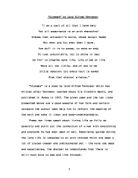A sense of tiredness from waiting for her lover is emphasised through the form of the poem. The repetition of a quatrain at the end of each stanza, with only slight variation, where Mariana continually called out and expressed her grief, emphasises the length of time Mariana is secluded in the grange, and indeed the length of time that she has been waiting for Angelo to return. Thus, a sorrowful mood is created.
9 She only said, ‘My life us dreary,
He cometh not,’ she said;
She said, ‘I am aweary, aweary,
11 I would that I were dead!’
In the refrain, the elongated words, “dreary” and “aweary” symbolise Mariana’s longing and desperation for her lover to arrive. They also slow down the line, as extra weak syllables are added onto the end of the iambs, namely the “-y” of each word. But also, the lack of hard consonants makes Mariana sound tired as she says these words. Also, the feminine rhyme in the refrain, where weary and dreary rhyme, but the second syllable is a weak vowel, reiterates the tired tone with which Marianna speaks.
The stationary and solitary mood is created in Marianna even in the first line of the poem. Mariana is described as “in the moated grange.” Just as this epigraph lacks any kind of movement, as it lacks even a verb, the rest of the poem lacks any narrative movement as well. Therefore the rest of the poem merely elongates this image of a melancholic loneliness.
The helplessness of Mariana’s situation in the poem is signalled in the third stanza. The idea of the “moated” grange, which is repeated from the epigraph, reinforces the sense of entrapment – Mariana is surrounded by water, and alone. The fact that there is “a sluice with blacken’d waters” proves this stagnation of the water, and how everything is in a state of slowing, as Marianna is. The caesura before “without hope of change” emphasises this further, as not only is she physically trapped as she is surrounded, but also that she is trapped in the repetitive nature which her life seems to be leading, and at last, she has given up hope that something will change from this norm.
The lack of change in tone with the change in the time of the day emphasises Mariana’s stagnating life. In terms of the plot, nothing actually changes – Marianna is still in the same place at the end as she was at the beginning. In contrast, the changing of time from “morn to eventide” shows how life continues around her. Marianna is herself not quite living: she is in a dreamlike state, as she is so tired, where “in sleep she seem’d to walk forlorn.” The word forlorn is very emotive and gives the stanza a melancholy tone, which is emphasised by the long vowel sounds in ‘gray-eyed morn’. The adjective ‘morn’ is also homophonous with ‘mourn’, furthering the idea of Mariana’s severe depression, as if mourning for her life.
Tennyson also begins to suggest the reason for her depression in the latter half of the poem, by introducing the symbol of the ‘poplar’ tree. He writes that ‘the shadow of the poplar fell/Upon her bed’, which perhaps symbolises her sexual desire for Angelo, and frustration at his absence, as she waits for him to ‘come’. The enjambment between ‘fell’ and ‘upon’ emphasises Mariana’s desperation in waiting for Angelo to arrive. It is also quite an ominous image, as shadows have connotations with death and darkness, which emphasises the hopelessness of her situation in her reiterated sigh ‘He cometh not’.
In the poem, there is a overcast theme of death. “Dead” is repeated in the last line of every stanza, which emphasises the travesty that Mariana is going through. In the last stanza Tennyson writes ‘…; but most she loathed the hour When the thick-moted sunbeam lay Athwart the chambers’. The phrase is emphasised by the caesura directly before it, and the comparatively long time without a break for punctuation. This image of dust in the sunlight, (from thick moted) has connotations of decay and death. In particular, the words ‘thick’ and ‘lay’ make it seem very oppressive and heavy, which emphasises the slowing down of Marianna’s life. This idea is furthered as the image is one of the day drawing to a close; ‘And the day Was sloping toward his western bower’. This suggests that the sun is moving away from Mariana and setting, and moving towards Angelo. In particular, light has connotations of live and vitality – and so the lack of light creates a drained mood – reflective of Mariana’s mood.
In the last stanza the refrain is different to the rest of the poem, which changes the tone entirely. Mariana appears to accept her fate, as she says ‘He will not come’, rather than ‘He cometh not’ which means her only sense of purpose, to wait for him, has been destroyed. Rather than ‘I were that I were dead!’, which is repeated in the rest of the poem, the last line is ‘Oh God, that I were dead!’ This line has the added impact of the intensifier ‘Oh God’, which creates a mood of desperation - far more poignant than in the rest of the poem. It is as though, as the poem draws to a close, Mariana’s life does too.










